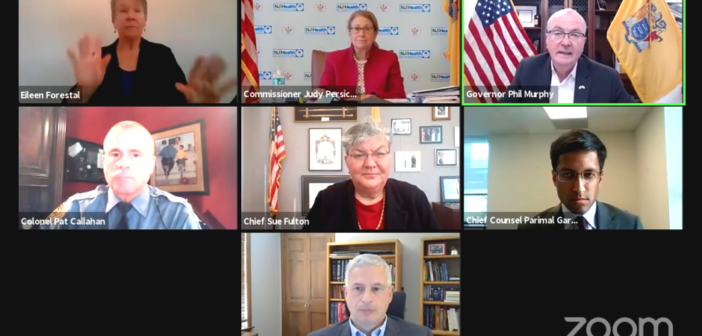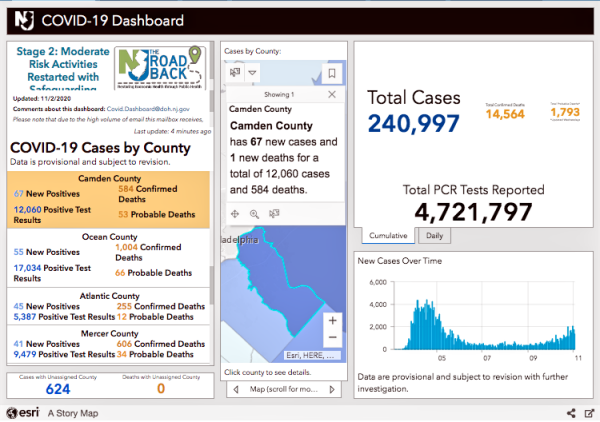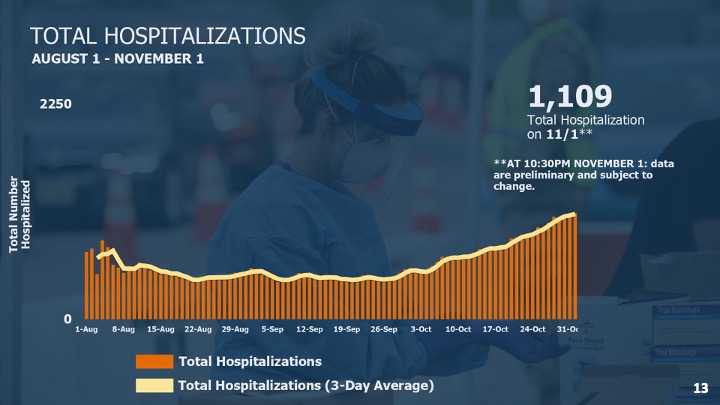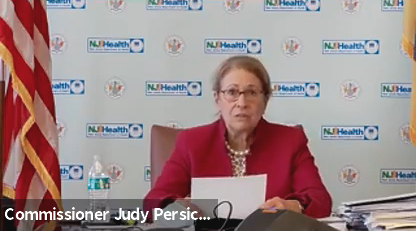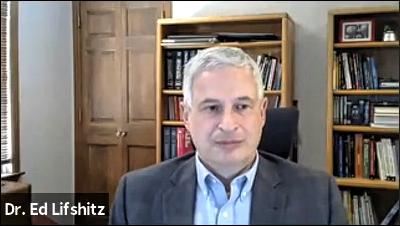New Jersey has seen more than 1,000 new infections daily for the past two weeks. Officials urge vigilance, and continue to blame private, indoor gatherings for the second wave of cases.
By Matt Skoufalos | November 2, 2020
Another 1,379 New Jersey residents have tested positive for novel coronavirus (COVID-19), bringing the statewide total to 240,997 cases, Governor Phil Murphy reported Monday.
Sadly, three more residents have perished from complications related to the virus, bringing the statewide death toll to 14,564 lives lost during the pandemic.
In addition to those lab-confirmed fatalities, the state has acknowledged another 1,793 probable COVID-19-related deaths.
Since March, 429 of every 100,000 New Jersey residents have been hospitalized with COVID-19, and 166 of every 100,000 have died from COVID-19-related complications.
More than 4.72 million polymerase chain reaction (PCR) tests for COVID-19 have been performed statewide, with a 2.73-percent positivity rate per 100,000 residents.
Rate of transmission (Rt) at 1.25, spot positivity highest in South Jersey
The statewide average of COVID-19 spot positivity testing stood at 5.29 percent October 29; in South Jersey, it was highest, at 6.74 percent.
Rt, the variable that describes the seven-day, rolling-average rate of transmission of new COVID-19 cases, hit 1.28 from samples taken October 28.
An Rt figure greater than 1.0 means that each new COVID-19 patient is infecting more than one other person, on average, and the spread of the virus is increasing.
Since its mid-April COVID-19 spike, the highest reported RT in New Jersey was 1.48, recorded August 1. The lowest was 0.62, recorded June 9.
Hospitalizations continue to climb
Throughout New Jersey, 1,109 people currently are hospitalized with a suspected case of COVID-19, marking the sixth day in a row of more than 1,000 suspected COVID-19 patients, Murphy said.
Of those, 947 have tested positive for COVID-19, and 162 are awaiting confirmation of their symptoms.
Among those hospitalized patients, 212 are in intensive or critical care, and 100 of the ICU and critical-care patients (47 percent) are on ventilators.
Across the state, 827 long-term care (LTC) centers have reported at least one case of COVID-19, and 188 are dealing with an active outbreak. LTCs account for 39,853 infected patients and staff in New Jersey, or 17 percent of total cases.
That includes 25,679 residents and 14,174 staffers sickened by the virus, as well as 7,226 lab-confirmed resident and staff deaths (50 percent of the statewide total), with facilities self-reporting 121 staff deaths.
Of 656 veterans residing in a state-run home, 395 residents have tested positive for COVID-19, and 146 have died from complications related to the virus. Ten veterans presently are hospitalized with COVID-19, and 248 have recovered from the virus.
At state-run psychiatric facilities, 223 of 1,175 patients and 538 staff members have tested positive for COVID-19. Thirteen patients and seven staffers have died from complications related to the virus.
To date, 60 New Jersey children aged 1 to 18 have been diagnosed with pediatric multisystem inflammatory syndrome, New Jersey Health Commissioner Judy Persichilli said.
All those pediatric patients have tested positive for an active COVID-19 infection or the presence of COVID-19 antibodies, indicating exposure to the virus. No deaths have been associated with this syndrome in New Jersey, although several children have been hospitalized during their treatment.
Since August 1, 28 COVID-19 outbreaks encompassing 122 individual cases have been traced to schools in 15 New Jersey counties. In Camden County, three outbreaks have been linked to 35 cases.
Preliminary modeling shows second wave won’t peak until Q1 2021
Amid a troublingly prolonged increase in new COVID-19 infections, hospitalizations, and critical-care patients, Persichilli said Monday that the second wave of the virus isn’t expected to peak until the first quarter of 2021.
Despite acknowledging that that projection is based upon “very preliminary predictive models,” the health commissioner said that officials would be vigilant “from now on to March.”
New Jersey “tracked a slight uptick” with re-openings of schools and businesses, but that hasn’t threatened to overwhelm its hospitals, she said. However, after logging more than 1,000 new infections per day for more than two weeks, residents are once again being plunged into “those difficult days in March and April,” Persichilli said.
“Back then, all of you did the hard work to bring down our case numbers,” she said. “You took personal responsibility. All of you responded to the call to protect one another from COVID-19.”
The commissioner urged residents to “continue vital prevention efforts,” including social distancing, wearing a mask, washing hands often, using hand sanitizer, and staying home when sick or if exposed to someone with COVID-19.
Murphy echoed her remarks, adding that officials “felt the risk [around reopening business and schools]was manageable, and it was responsible risk.
“It’s the gatherings that are not capacity-limited that are beyond our control, or that we’re worried about,” the governor said. “That is where our concern is, and that is where we think the indoor exposure is coming from.”
Newest increases among 35-55-year-olds
Unlike in the summer, when most new cases were being driven by 18-to-29-year-olds, the latest wave of infections is observable among “working-age people,” said Dr. Ed Lifshitz, head of New Jersey’s communicable disease service.
“The good news is that age group [18-to-29] has leveled off,” Lifshitz said.
“The bad news is 35-to-55-year-olds are driving the big increases that we’re seeing now.
“We’re beginning to see more of what we had been traditionally seeing,” he said. “[Infections among] high schools and colleges has largely flattened out, whereas [those among]the working adults have increased.”
Murphy said that he hopes new workplace protections extended by his executive order last week will make a dent in those figures.
Read our ongoing round-up of COVID-19 coverage here.
Please support NJ Pen with a subscription. Get e-mails, follow us on Facebook, Twitter, and Instagram, or try our Direct Dispatch text alerts.

